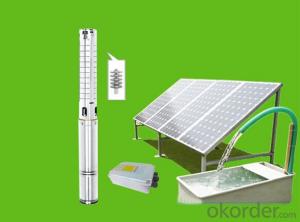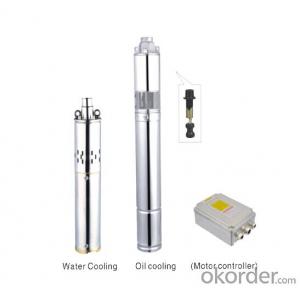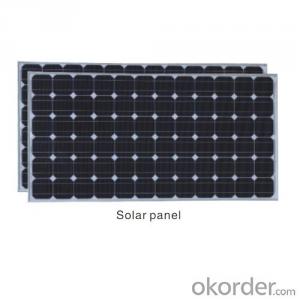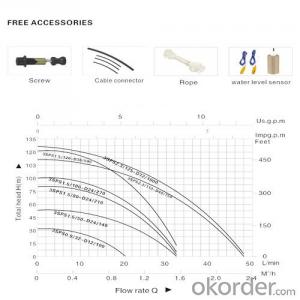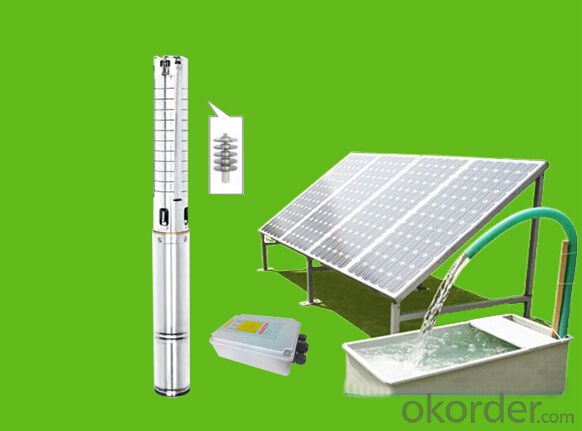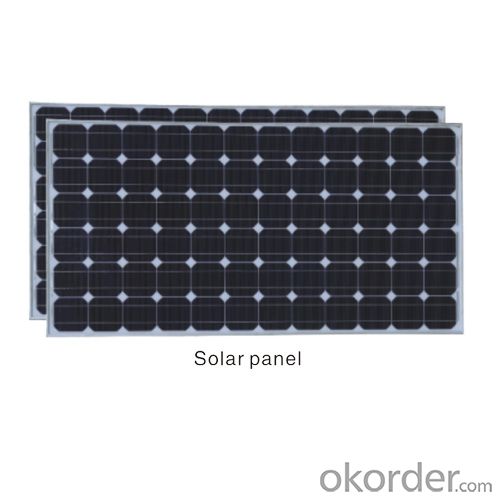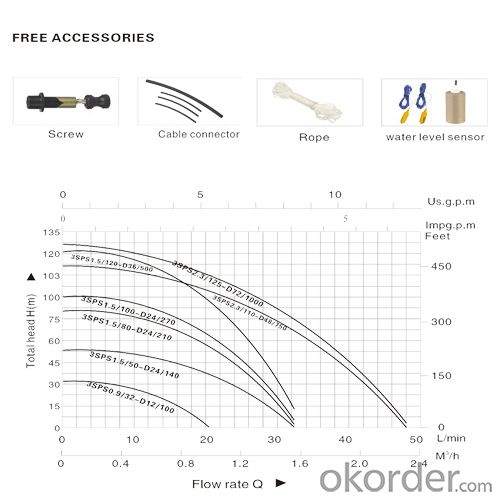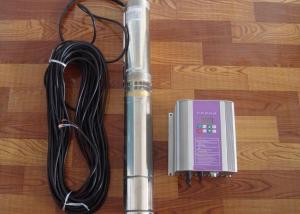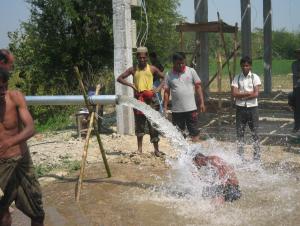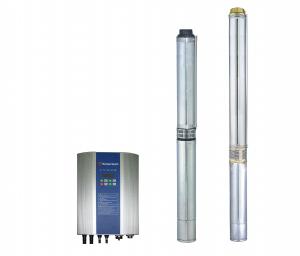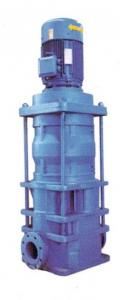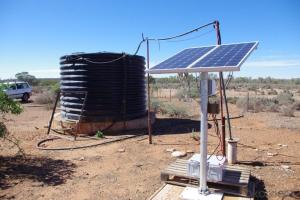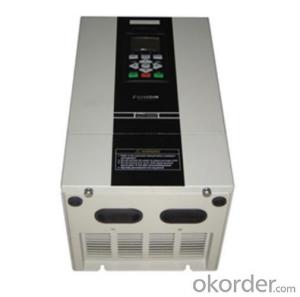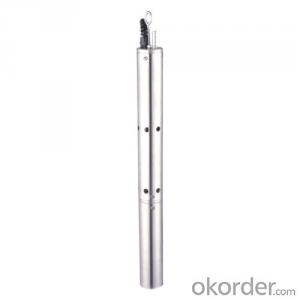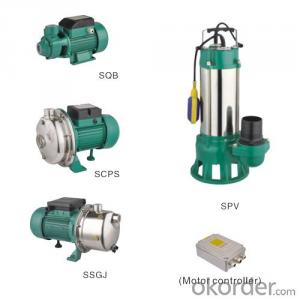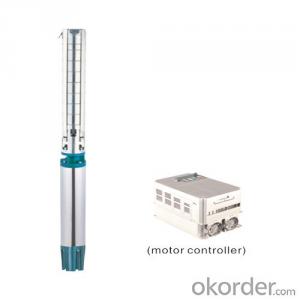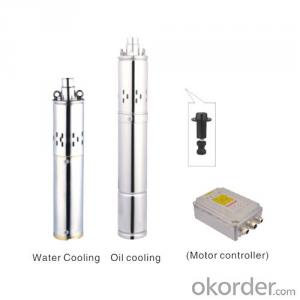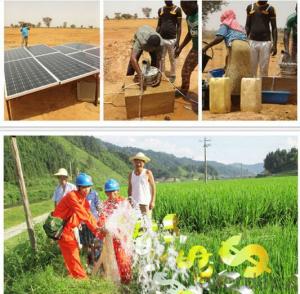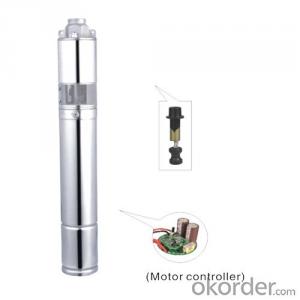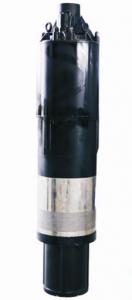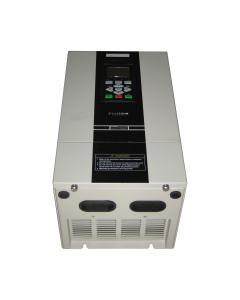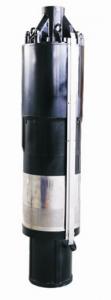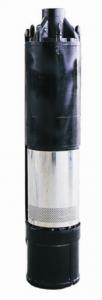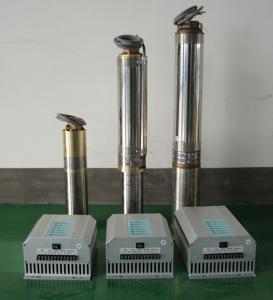Sunrotor Solar Pump for Wells - CE Certified, Easy Install
- Loading Port:
- Ningbo
- Payment Terms:
- TT OR LC
- Min Order Qty:
- 10 unit
- Supply Capability:
- 100000 unit/month
OKorder Service Pledge
OKorder Financial Service
You Might Also Like
Specifications
submersible solar water pump
1. CE certificated
2. easy install
3. high efficiency: over 90%
4. long life time: 8-10 years
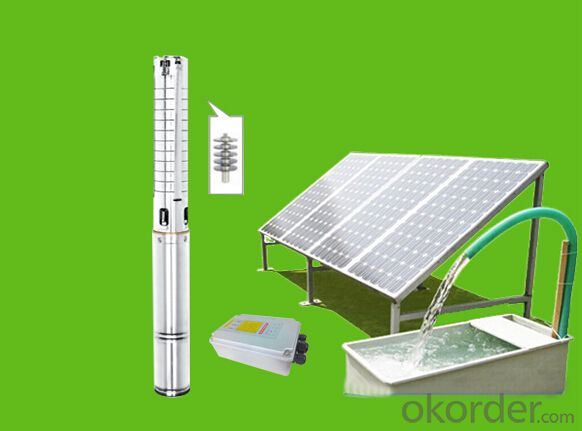
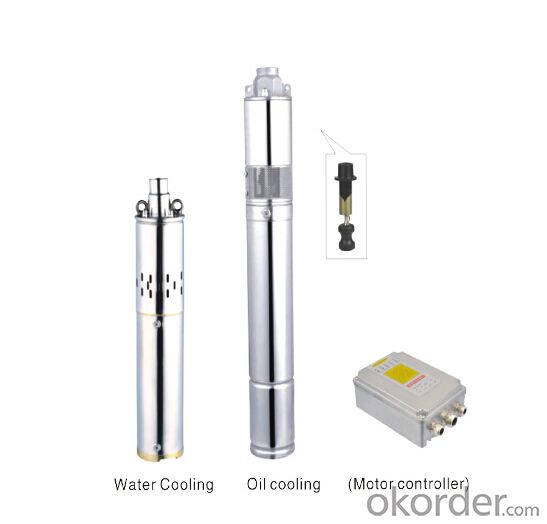
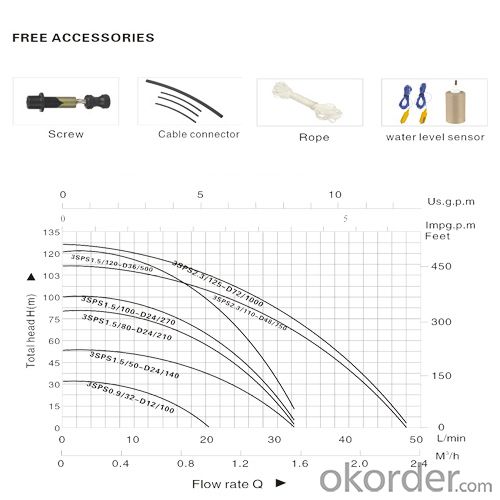
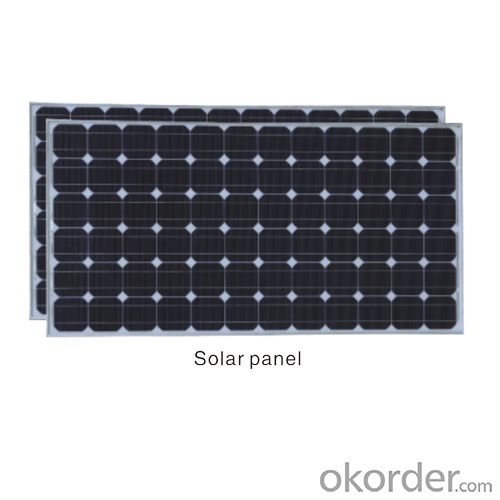
1. Profile:
Adopt stainless steel screw and rubber stator, permanent Magnet Brushless motor. With combination of motor and controller, the max efficiency is over 85%, raises 25% than the traditional AC one.
2. Material:
1)Stainless steel casing, shaft core, coupling and pump body; copper alloy connecting, base; rubber stator of high-strength and wear-resistant.
2)Water immersion style stainless steel submersible motor; graphite bearings.
3. Product Feature:
1)Compact structure, high-lift, noiseless, pollution-free; complete electrical protecting controller device, against under-voltage, over-voltage, over-flow, overload, waterless etc;automatic recovery; controlling water height as demand.
2)Easy installation, maintenance-free, safe and reliable.
Water depth: 1 -120m Max flow: 2.3m3/h
4. Application:
1) These electric pumps series are workable within maximum head, as there are no restrictions of BDC. With the addition of high head, high efficiency
and wide high efficiency zone, they are suitable for distance water irrigation, high efficiency of increasing oxygen on aquaculture, pumping water from deep well, gardening, fountain and etc.
5. Working condition:
1) Non-corrosive water; the volume ratio of sand content no more than 1%。particle size less than 0.2mm.
2) Max medium temperature up to +40°C; PH value remains 6.5-8.5.
3) Work close to the rated head and must be immersed in water.
motor data
| Model | Impeller | Voltage (V) | Power (W) | Max Flow (M3/H) | Max Head (M) | Outlet (IN) | Outer Diameter (MM) | Weight (KG) |
| 3SPS0.72/20-D12/80 | Screw | 12 | 45-150 | 0.72 | 20 | 0.75" | 76*400 | 6.5 |
| 3SPS0.76/28-D12/120 | Screw | 12 | 120 | 0.76 | 28 | 0.75" | 76*400 | 6.7 |
| 3SPS0.86/38-D12/150 | Screw | 12 | 150 | 0.86 | 38 | 0.75" | 76*400 | 6.8 |
| 3SPS1.0/30-D24/80 | Screw | 22-30 | 45-150 | 1 | 30 | 0.75" | 76*400 | 7 |
| 3SPS1.3/50-D24/140 | Screw | 22-30 | 80-200 | 1.3 | 50 | 0.75" | 76*400 | 7.2 |
| 3SPS1.5/80-D24/210 | Screw | 22-30 | 100-270 | 1.5 | 80 | 0.75" | 76*400 | 7.5 |
| 3SPS1.5/95-D36/270 | Screw | 32-43 | 140-350 | 1.5 | 95 | 0.75" | 76*400 | 8 |
| 3SPS1.5/115-D36/500 | Screw | 32-43 | 320-800 | 1.5 | 115 | 0.75" | 76*460 | 9 |
| 3SPS2.3/80-D48/750 | Screw | 42-63 | 480-950 | 2.3 | 80 | 0.75" | 76*460 | 9 |
| 3SPS2.3/95-D72/1000 | Screw | 42-88 | 600-1200 | 2.3 | 95 | 0.75" | 76*460 | 9.5 |
| 3SPS2.3/120-D72/1300 | Screw | 42-88 | 800-1500 | 2.3 | 120 | 0.75" | 76*460 | 9.5 |
| 4SPS3/60-D36/500 | Screw | 32-43 | 300-700 | 3 | 60 | 1" | 100*480 | 10 |
| 4SPS3.6/80-D48/750 | Screw | 42-63 | 450-1000 | 3.6 | 80 | 1" | 100*480 | 10.5 |
| 4SPS3.8/95-D72/1000 | Screw | 42-88 | 600-1300 | 3.8 | 95 | 1" | 100*550 | 13.5 |
| 4SPS4.2/100-D72/1300 | Screw | 42-88 | 800-1550 | 4.2 | 100 | 1" | 100*550 | 14 |
Product Description
Product Feature
Solar submersible pumps is the efficient equipment to extract groundwater in applications of agricultural irrigation, human and livestock water in plateau and mountain areas, etc.
1. Motor and shell made of stainless steel
2. Stainless steel shaft and coupling
3. High strength & wear resistance stainless steel impeller and diversion shell
4. Sand resistance, anti-rust, pollution-free, long life time
5. Small size, light and easy to ship
6. Easy installation and easy maintain
7. High efficient smart controller with multiple protections: over-temperature protection,
short-current protection, over-load and under-voltage protection. Safe and reliable to use.
Price includes pump with controller. Solar PV panels may be purchased separately.
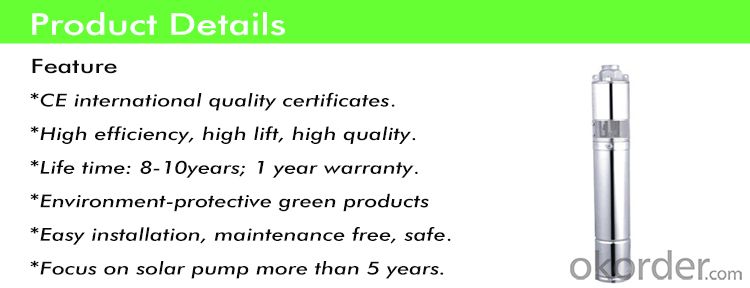
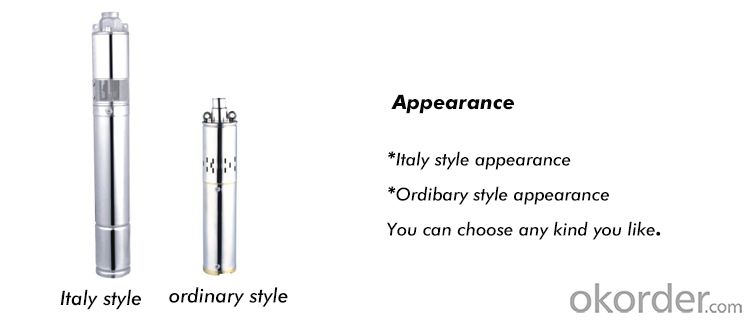




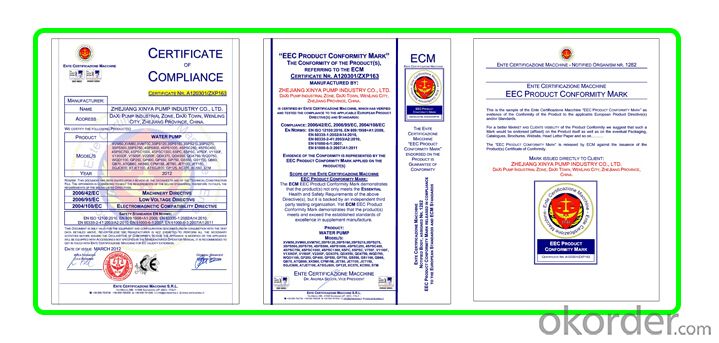
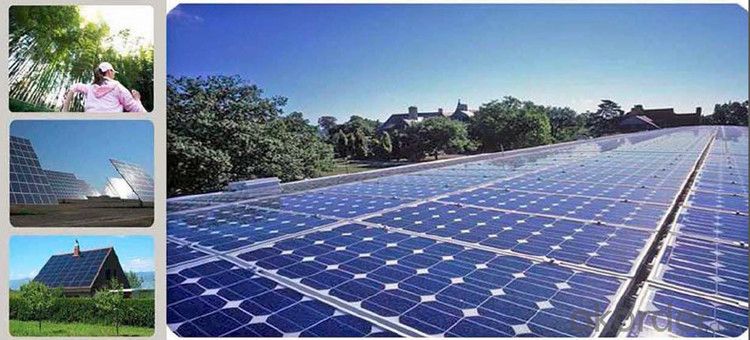
CNBMSOLAR is a world-leading and Vertical integrated manufacturer of high-performance with Silicon, Wafer, Cells,
Modules, which convert sunlight into electricity for residential, commercial, and utility-scale power generation.
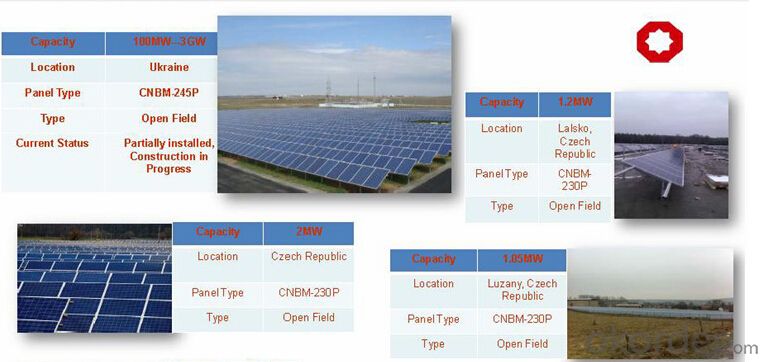
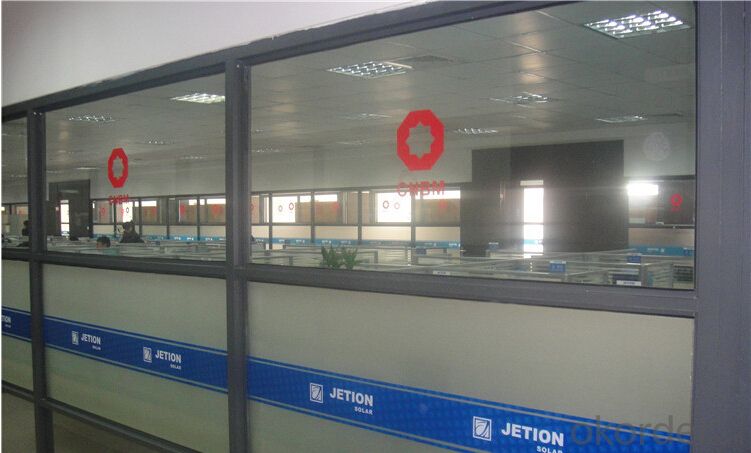
FAQ
Q1. When can I get the quotation?
We usually quote within 24 hours after we get your inquiry. If you are urgent to get the price, please send the message on trade manager or call us directly.
Q2. Can I buy one as sample?
Yes, of course. MOQ of solar pump is 1 piece. For the other kind of products (water pump, air compressor and welding machine), you need to pay all the fee when we make the sample.
Q3. Can you make OEM?
Yes, you can put your logo and brand on the box.
Q4. What is your main market?
Eastern Europe, Southeast Asia. Mid East, South America, Northern Europe.
- Q: Can a solar pump be used for water supply in military or defense operations?
- Yes, a solar pump can be used for water supply in military or defense operations. Solar pumps are a reliable and sustainable solution for providing water in remote or off-grid locations, which is often required in such operations. They can operate independently of traditional power sources, reducing the logistics and reliance on fuel supplies. Additionally, solar pumps are generally low-maintenance and can be easily deployed, making them suitable for military or defense applications.
- Q: Can a solar pump be used for geothermal heating or cooling?
- No, it is not possible to use a solar pump for geothermal heating or cooling. Geothermal heating and cooling systems make use of the Earth's internal heat to provide temperature control for a building. This is accomplished by circulating a liquid through pipes buried underground, which absorbs or releases heat depending on the time of year. Conversely, a solar pump is specifically designed to circulate water or other fluids using energy from the sun. Although both systems rely on renewable energy sources, they have distinct functions and cannot be used interchangeably.
- Q: Are there any maintenance requirements for the solar panels used in a solar pump system?
- Yes, there are maintenance requirements for the solar panels used in a solar pump system. Regular maintenance is essential to ensure the efficient functioning and longevity of the solar panels. Some common maintenance requirements include: 1. Cleaning: Solar panels can accumulate dust, dirt, leaves, and bird droppings over time, which can reduce their efficiency. Regularly cleaning the panels with water and a soft brush can help remove these contaminants and ensure optimal performance. 2. Inspection: Regularly inspecting the solar panels for any signs of damage, such as cracks, loose connections, or corrosion, is important. Any issues should be addressed promptly to avoid further damage or reduced efficiency. 3. Monitoring: Monitoring the performance of the solar panels regularly helps identify any abnormal behavior or drop in efficiency. This can be done by observing the output levels or using monitoring systems that provide real-time data on the panel's performance. 4. Shading: Ensuring that the solar panels are not shaded by trees, buildings, or other obstructions is crucial. Shading can significantly reduce the energy output, so trimming any overhanging branches or removing objects blocking sunlight is important. 5. Battery maintenance: If the solar pump system has a battery, it is essential to monitor and maintain the battery's health. This may involve checking the battery's charge levels, cleaning the terminals, and replacing the battery when necessary. 6. Professional servicing: It is recommended to have a professional inspect and service the solar pump system periodically. They can perform more advanced maintenance tasks, such as checking the inverter, testing the electrical connections, or evaluating the overall system performance. By following these maintenance requirements, solar panels used in a solar pump system can operate at their maximum potential and have a longer lifespan, ensuring consistent and reliable water pumping.
- Q: Can a solar pump be used for pool circulation?
- Yes, a solar pump can be used for pool circulation. Solar pumps are designed to circulate water using solar energy, making them an efficient and eco-friendly option for pool owners. They help in maintaining water clarity and preventing stagnation by continuously circulating and filtering the pool water. Additionally, solar pumps can save on electricity costs as they harness the power of the sun to operate.
- Q: Can a solar pump be used in agricultural applications?
- Yes, a solar pump can definitely be used in agricultural applications. Solar pumps are a sustainable and cost-effective solution for farmers who need to access water for irrigation purposes. These pumps are powered by solar energy, which is abundant and renewable. They can be used to draw water from various sources such as wells, boreholes, rivers, and lakes, providing a reliable and consistent water supply for crops. Solar pumps are also easy to install and require minimal maintenance, making them a practical choice for agricultural applications. Additionally, using solar pumps in agriculture helps reduce carbon emissions and dependence on fossil fuels, contributing to a more environmentally friendly farming practice.
- Q: Can a solar pump be used for solar water heating systems?
- Solar pumps are not suitable for solar water heating systems. Despite both using solar energy as a power source, they have distinct purposes. Solar pumps are designed exclusively for extracting water from wells or other water sources by utilizing solar energy. They are commonly employed for irrigation, water supply in remote areas, or circulating water in swimming pools. On the contrary, solar water heating systems utilize solar energy to warm water for domestic or commercial use. These systems typically include solar collectors that absorb sunlight and transfer the heat to water. The heated water is then stored in a tank for later use. Unlike solar pumps, these systems do not require a pump for water circulation since heat transfer occurs naturally through convection. Consequently, although both solar pumps and solar water heating systems rely on solar energy, their functions are distinct, and they cannot be used interchangeably.
- Q: How does the cost of a solar pump compare to a traditional pump?
- The cost of a solar pump is typically higher than that of a traditional pump upfront. However, in the long run, a solar pump can be more cost-effective due to its lower operational and maintenance costs, as it relies on renewable energy and does not require fuel or electricity. Additionally, solar pumps can qualify for financial incentives and grants, further reducing the overall cost.
- Q: Can a solar pump be used for livestock watering?
- Yes, a solar pump can be used for livestock watering. Solar pumps are a sustainable and cost-effective solution for providing water to livestock in remote areas where electricity may not be readily available. These pumps harness energy from the sun to power their operation, making them an environmentally friendly option. They can be used to pump water from wells, boreholes, or other water sources to provide a reliable supply for livestock watering.
- Q: Are there any safety considerations for solar pump installations?
- Yes, there are several safety considerations for solar pump installations. Firstly, proper installation and grounding of the solar panels and electrical components are crucial to prevent electric shock hazards. It is important to follow the manufacturer's instructions and local electrical codes during installation. Additionally, regular maintenance and inspection of the system are necessary to identify any potential issues or malfunctions that could pose safety risks. It is also advisable to have a disconnect switch or breaker in place to shut off power during maintenance or emergencies. Lastly, precautions should be taken to protect the pump and its components from extreme weather conditions, such as lightning strikes or flooding, which could affect the system's performance and safety.
- Q: Can solar pumps be used for water supply in recreational facilities or parks?
- Yes, solar pumps can definitely be used for water supply in recreational facilities or parks. Solar pumps are an environmentally-friendly and cost-effective solution that can provide a reliable and sustainable water supply for various recreational activities such as water features, swimming pools, irrigation systems, and water fountains. Their ability to harness solar energy makes them ideal for remote or off-grid locations, reducing the reliance on traditional power sources and minimizing operational costs. Additionally, solar pumps require minimal maintenance and can be easily integrated into existing infrastructure, making them a suitable choice for water supply in recreational facilities or parks.
Send your message to us
Sunrotor Solar Pump for Wells - CE Certified, Easy Install
- Loading Port:
- Ningbo
- Payment Terms:
- TT OR LC
- Min Order Qty:
- 10 unit
- Supply Capability:
- 100000 unit/month
OKorder Service Pledge
OKorder Financial Service
Similar products
Hot products
Hot Searches
Related keywords
